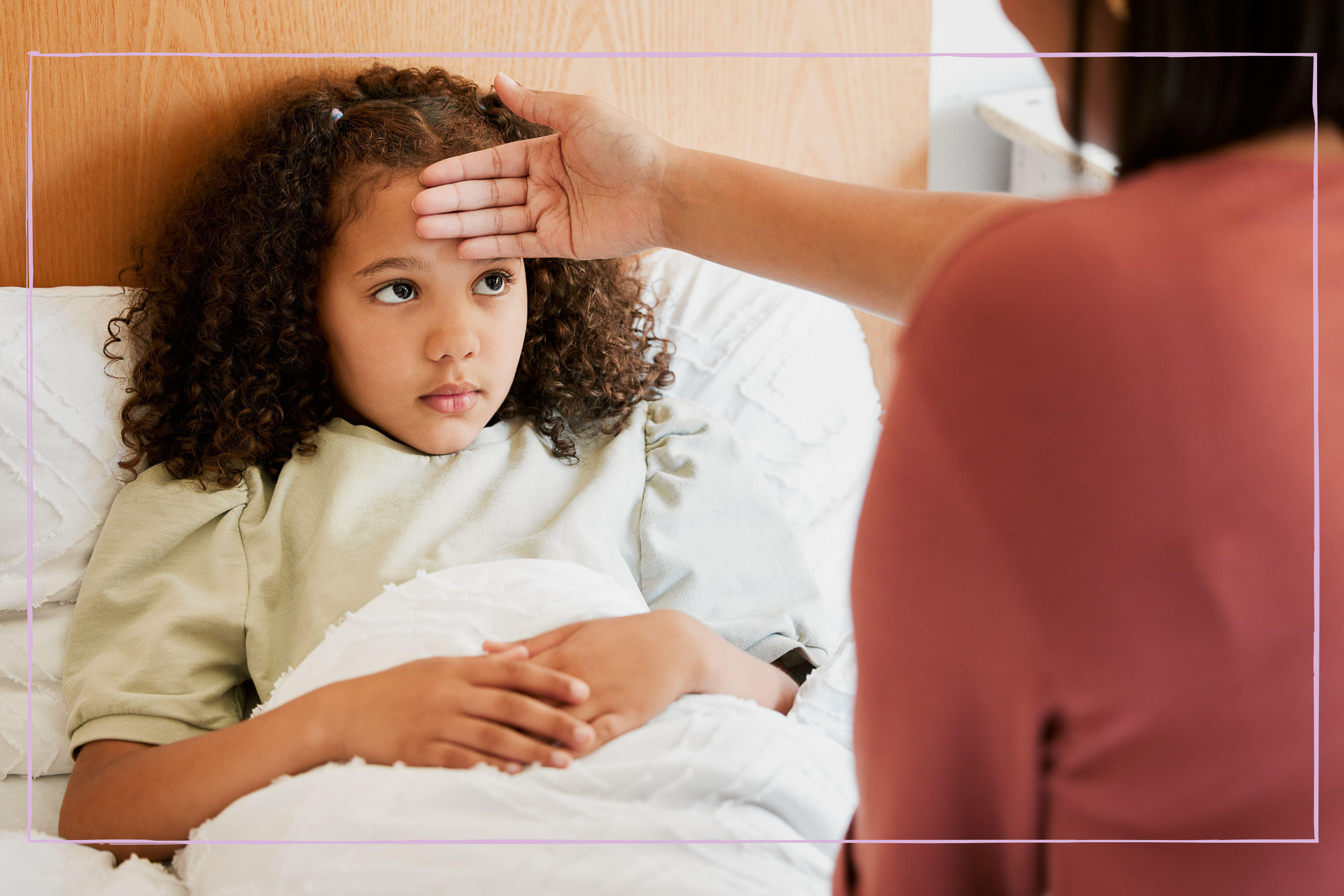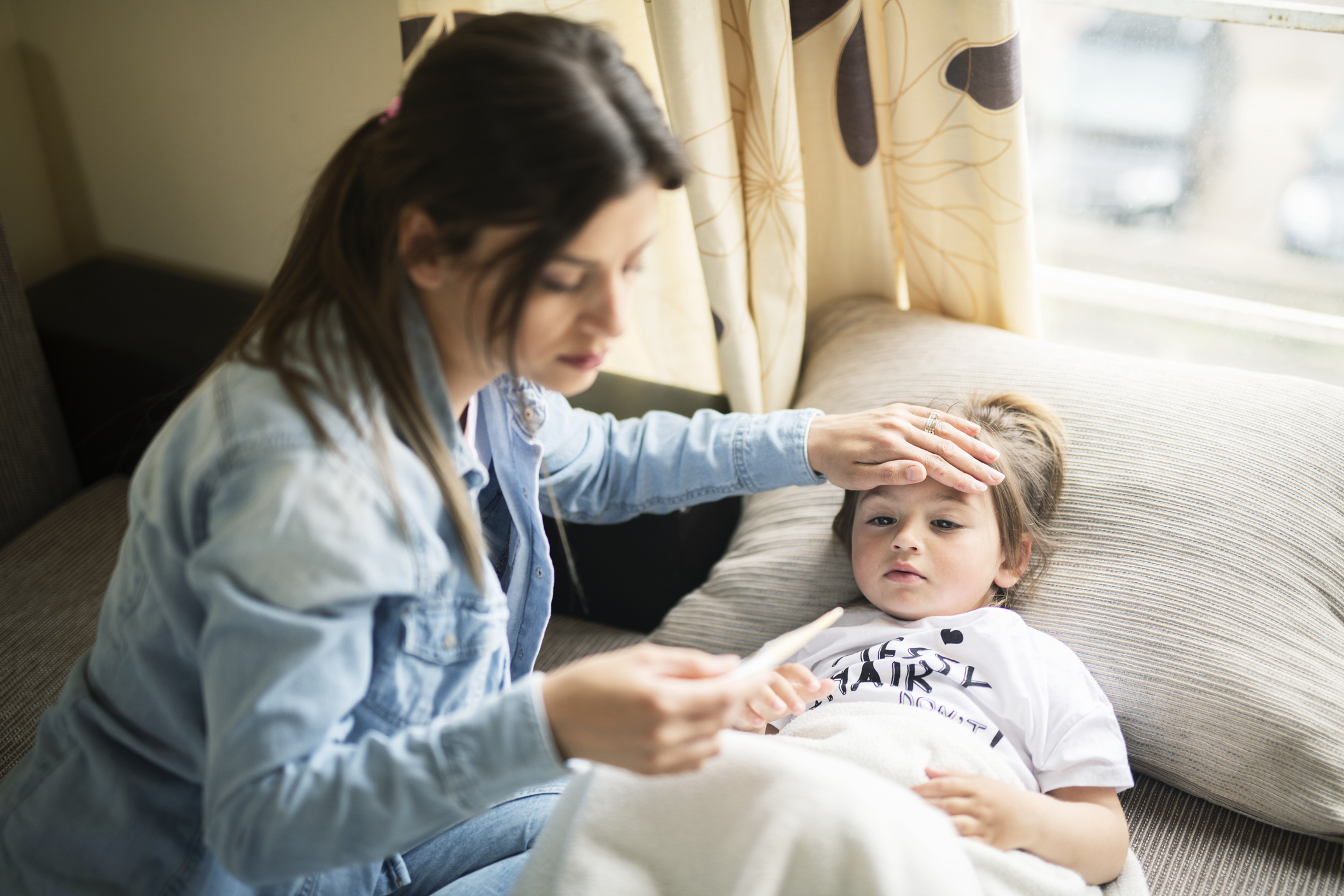What’s a healthy temperature range for children and what to do if they have a fever
It's important to check, especially if you or your children feel under the weather

Whether you’re a first-time parent or not, seeing your baby or young child with a temperature can be stressful and worrying.
A baby won’t be able to tell you when they’re feeling poorly and a temperature can often be one of the first signs that they have an infection or inflammation somewhere in their body. In most cases you can treat a temperature at home but if your baby is under three months it’s advisable to take them to the doctor.
NHS GP Dr Nabeel Arshad, who works at the Brooke Surgery in Greater Manchester, says: “We class a high temperature (or fever) as 38 degrees or more, and usually we’d expect a child that has a high temperature to return back to normal within four days.” He says common childhood illnesses such as chickenpox, coughs or colds can be accompanied by a high temperature but don’t usually require medical attention.
We’ve spoken to some medical experts about how best to look after your child when they have a temperature and the symptoms to look out for which may mean the situation is more serious.
When to worry about a fever in children
Most fevers will go away on their own, sometimes they can be a sign that your child is quite poorly and needs urgent medical attention. You should call 999 if your baby or child has any of these symptoms outlined by the NHS:
- Persistent high fever that is not improving
- Is bothered by light
- Has a rash that will not fade with light pressure from a glass
- Has had a fit for the first time (febrile seizure)
- Has a stiff neck
- Unusually cold hands and feet
- Is drowsy and hard to wake
- Has difficult breathing or is breathless or breathing fast
- Is extremely agitated or confused
- Has changes to their skin colour such as blue, grey, or pale or blotchy skin
- Is not themselves and not eating or playing as they normally would
What’s a healthy temperature range for children?
The NHS defines a normal temperature for babies and children as 36.4C or in the 35.5-37.5C range. Anything over 38C can be classed as a temperature in a baby or child. Every person has their own normal body temperature and when it goes above this number, for whatever reason, this will be defined as a temperature.
It’s worth noting down what your child’s normal temperature range is when they are healthy so you will quickly know if they are poorly. A child’s body temperature may fluctuate during the day depending on whether they’ve been active, what clothes they’re wearing or if they’ve just had a bath. But, as well as feeling warm, a child with a temperature may also have flushed cheeks and feel sweaty or clammy and other symptoms of illness such as lethargy.
Parenting advice, hot topics, best buys and family finance tips delivered straight to your inbox.
What constitutes a fever in children?
A child is typically thought to have a fever when a thermometer shows 38C or above. You might hear about fevers being separated into ‘low grade’ and ‘high grade’ categories. A low grade fever is one which is only slightly above a child’s normal body temperature and might accompany a cold or another mild illness.
A high grade fever is one which rises to 40C or 41C and is a sign of a more serious infection such as COVID-19 or another type of illness. It may mean that a child is very low in energy and has a low appetite. If your child has a high grade fever, you should take them to the doctor as soon as possible.
How to measure temperature
When you become a parent a digital thermometer may become your new, most-used gadget. It is the best way to get a fast and accurate reading of your baby’s temperature and you can buy them in most pharmacies or supermarkets.
You can take the reading from different parts of your baby’s body, including their ear, forehead and armpit. Always read the label on whichever thermometer you’ve chosen and take a few readings to check for consistency.
- Ear thermometer - An ear thermometer is a pricier product than other types but is quick to use and easy to read. The main drawback with this type of thermometer is that it can be tricky to get it into the right position if your baby or child is wriggling. Babies’ ear holes are very small so you may not be able to get the device in the right place to get a true reading.
- Armpit thermometer - This type of thermometer is recommended for use in children under 5. Put the device in your child’s armpit and hold their arm against their body to keep it in place for around 15 seconds. The device might beep when it’s ready or you can just remove it to check the reading on the display.
- Forehead thermometer - We wouldn’t recommend you use these types of thermometers. They are strips which are held against the forehead but they give you the temperature of the skin rather than the body so aren’t accurate.
Common causes of fever in children
Dr Sharon Silberstein, who runs a medical clinic for parents in north London, says: “The most common reason for a fever is usually an infection. It’s a physiological reaction of the body to increase the core temperature, which makes it more difficult for bacteria and viruses to survive.”
It can take some time for babies’ and children’s immune systems to develop which means they can be susceptible to common bugs which are passed around nurseries and schools and from siblings. In the early years it can feel like you’re in a constant battle with germs. Fortunately, most of these childhood illnesses will pass in a few days, with some Calpol and cuddles.
Below is a list of common and more serious illnesses which have a temperature as one of the symptoms. Other symptoms of a fever might include chills, sweating, a headache, muscle aches and dehydration.
1. Common illnesses:
- Ear infection
- Tonsillitis
- Flu
- Chickenpox
- Hand, foot and mouth
- Kidney or urinary tract infection
2. Serious illnesses
- Meningitis
- Septicaemia
- Pneumonia
- COVID-19
3. Vaccinations
Some children can develop a high temperature after their childhood vaccinations. It can be especially common after the MenB vaccine and parents are advised to give liquid paracetamol (Calpol) after this jab. This immunisation is given at 8 weeks, 16 weeks and one year. The other vaccines which are part of the national immunisation programme do not usually cause a temperature.
The NHS says you should also give your baby plenty of fluids after the MenB jab and make sure they’re not wearing too many layers of clothing.
Managing a child’s fever at home
In most cases a child won’t need to see a doctor if they have a temperature and you will be able to ease their symptoms at home. Every childcare setting has its own protocol for temperatures in children but you will probably need to keep your child at home for a few days until they are better.
1. Stay hydrated
Dr Arshad says: “The key thing is to have plenty of fluids and to encourage your child to drink regularly. For breastfed children, continue to breastfeed as normal and for children on fluids just make sure they have access to water and can drink as much as they need to.” No extra water needs to be offered to a breastfed baby.
He adds that it’s important to keep an eye out for signs of dehydration which include going to the toilet less, a dry mouth, feeling lightheaded and sunken eyes. Check on your child regularly, and through the night, to check that they’re not deteriorating.
2. Keep your child cool
Dr Silberstein says it’s important to make sure your child doesn’t overheat. “Dress them in light clothing but don’t underdress them. You can use a cool compress for their head. Make sure the room is not too hot or too cold.” The NHS says you should not undress them or sponge them down to cool them down.
The Lullaby Trust says 16-20C is a safe temperature for a child’s room. You can buy a room thermometer if you’re not sure how to find out and maintain a safe temperature.
3. Over-the-counter medicines
- Calpol - Dr Silberstein says Calpol, which contains paracetamol, can be given to babies over 8 weeks old, who weigh over 4kg. The dose for this age is 2.5ml and it can be given every 4-6 hours but only up to 4 times in 24 hours.
Infants 6 to 24 months can have 5ml up to 4 times in 24 hours and this increases to 7.5ml for 2 to 4 year olds.
Children aged 4 to 6 can have 10ml up to 4 times a day.
Book an appointment to see your GP if you’ve been giving your child Calpol for three days and their symptoms aren’t improving. - Ibruprofen - The NHS says ibruprofen should not be given to a child under 3 months, who is under 5kg or who has chickenpox or is dehydrated. It should not be combined with Calpol unless your doctor has advised it. You should also not give ibuprofen to children who have asthma.
- Aspirin - is not safe for children under 16.

When to see a doctor about a fever
You should never apologise for taking your child to the doctor if you’re worried about them. A GP will tell you that they’d always rather see your baby or child and tell you they’re ok than for things to be left too late and become more serious.
Infants and Young Children
Dr Silberstein says you should contact your doctor or call 111 if your baby is under 3 months old with a fever of 38 degrees or higher. If your baby is over 3 months old but has a fever of 40C or higher, or it has been over 38.9C for two days, take them to your doctor straight away.
“It’s important to add that if your child starts to show signs of meningitis then call 999. Symptoms to look out for include a stiff neck, a rash that doesn’t fade with ‘the glass test’, if they have light sensitivity, if they’re having fits, their hands or feet feel very cold, if their skin goes blue or blotchy, very drowsy and struggling to stay awake or if they are very agitated,” Dr Arshad says.
Older Children
The same applies to older children as babies. If they have a persistent temperature for more than 3 days then you should take them to a doctor in case they have an infection which needs treatment with antibiotics.
An older child will be able to tell you how they feel but you should still look out for other symptoms such as a rash, dehydration and lethargy as they could be a sign of something more serious.
Special considerations
Children can also develop a temperature as a symptom of other health conditions, including autoimmune diseases such as multiple sclerosis, Addison’s disease and others. Some cancers and kidney and liver disease may all cause a fever but this is very rare.
If your child has recently had surgery and has a fever during their recovery, it could be a sign of an infection. Contact your doctor straight away as they may need to be prescribed antibiotics.
As we’ve stated above, fever is your body’s natural reaction to an infection and if your child has a raised temperature after a holiday or period travelling, you should speak to your doctor straight away. A travel health practitioner will hopefully have advised you of the vaccinations needed before your trip, but it’s still possible to contract diseases such as malaria and rabies in very rare circumstances.
Common myths about fever
Some people believe teething can lead to a temperature in babies and toddlers but the NHS says there’s little evidence for this. Their cheeks might look flushed and they might feel warm but the NHS says a fever (over 38C) is unlikely to be related to cutting new teeth.

Kat has been a digital journalist for over 15 years after starting her career at Sky News where she covered everything from terror attacks to royal babies and celebrity deaths. She has been working freelance for the last five years and regularly contributes to UK publications including Stylist, ES Best, Woman&Home, Metro and more.
